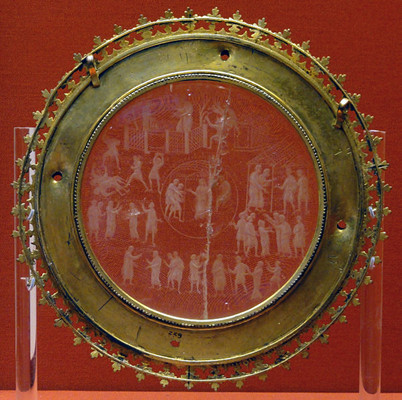"Daniel did what Rumpole at the Old Bailey would do if he thought he was cross-examining witnesses who were telling lies. One has to say that in real life Daniel would have been extremely lucky to have been thought to have demolished the witnesses, and to demonstrate their dishonesty by asking them one question each, but the principle is quite clear, and Daniel was clearly a very skilful cross-examiner."
但以理的做法與“老貝利律師”魯波爾一樣,如果覺得目擊證人在說謊,就要進行盤問。但以理只靠一個問題就揭穿了證人的謊言,推翻了他們的證詞,這種情況在現實生活中要算極其幸運的。但他的信條十分明確,手法相當老練。
Each scene on the crystal is a masterpiece of miniature carving, and in every scene, the artist has still found space for a small text in Latin, explaining what is going on. In the final scene is the ringing phrase, "Et salvatus est sanguis innoxius in die illa" - "And that day, innocent blood was saved".
水晶上的每一幅場景都是微雕杰作,這位藝術家也留出了一定空間, 用拉丁文為它們分別配上相應的故事內容。最后—幕畫面周圍環(huán)繞著一句“Et salvatus est sanguis innoxius in die ilia",即“那一天,無辜的流血得以幸免”。正是在這幅圖旁,我們找到了涉及洛泰爾國王名字的文字。
The king who commissioned the Susannah Crystal was descended from one of the great figures of medieval Europe - Charlemagne. Around 800, Charlemagne, King of the Franks, had created an empire that covered most of western Europe, including northern Italy, western Germany and modern France. This was the largest state that western Europe had seen since the disintegration of the Roman Empire, and the stability and prosperity of Charlemagne's empire allowed a great flourishing of the arts in the years after 800. Our crystal is a magnificent example of this so-called Carolingian Renaissance. This is a jewel that has always been valued and, for most of its existence, it was in the abbey of Waulsort in modern Belgium, in the centre of Charlemagne's empire. It was certainly there in the twelfth century, when the abbey's chronicle clearly describes it.
下令制作蘇撒拿水晶的國王,是中世紀歐洲赫赫有名的查理曼大帝的后代。公元八百年前后,法蘭克國王查理曼大帝所締造的帝國疆域幾乎瘈括了整個西歐,包含意大利北部、德國西部與現代法國。它是自羅馬帝國覆滅之后西歐最大的帝國。查理曼大帝治下的社會繁榮穩(wěn)定,使得接下來若干年內藝術發(fā)展欣欣向榮。水晶盤便是所謂“卡洛林文藝復興” 的絕佳代表。這件珍品一直備受推崇。大部分時間它都被珍藏在查理曼帝國的中心,今比利時境內的沃爾索修道院內,至少我們知道,十二世紀時它的確藏于此院,因為修道院的編年史有記載。












